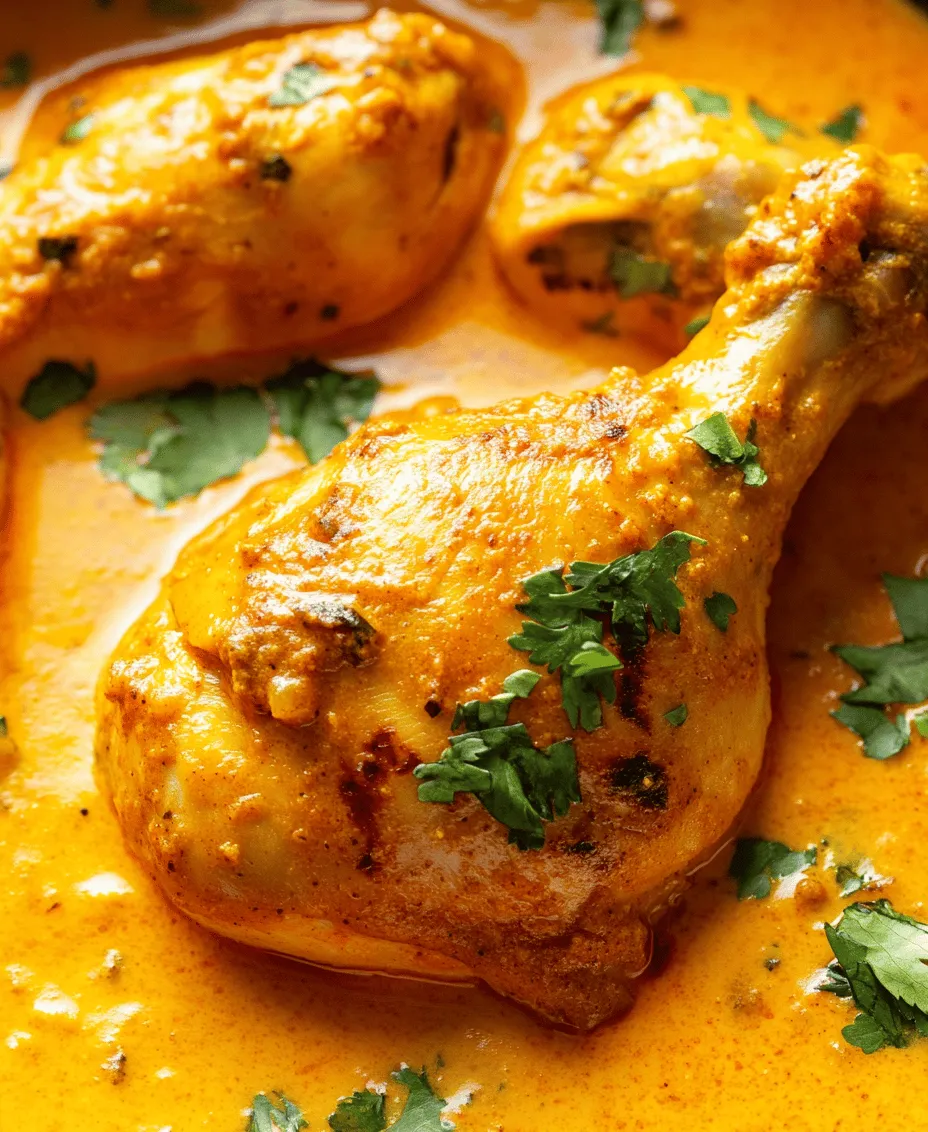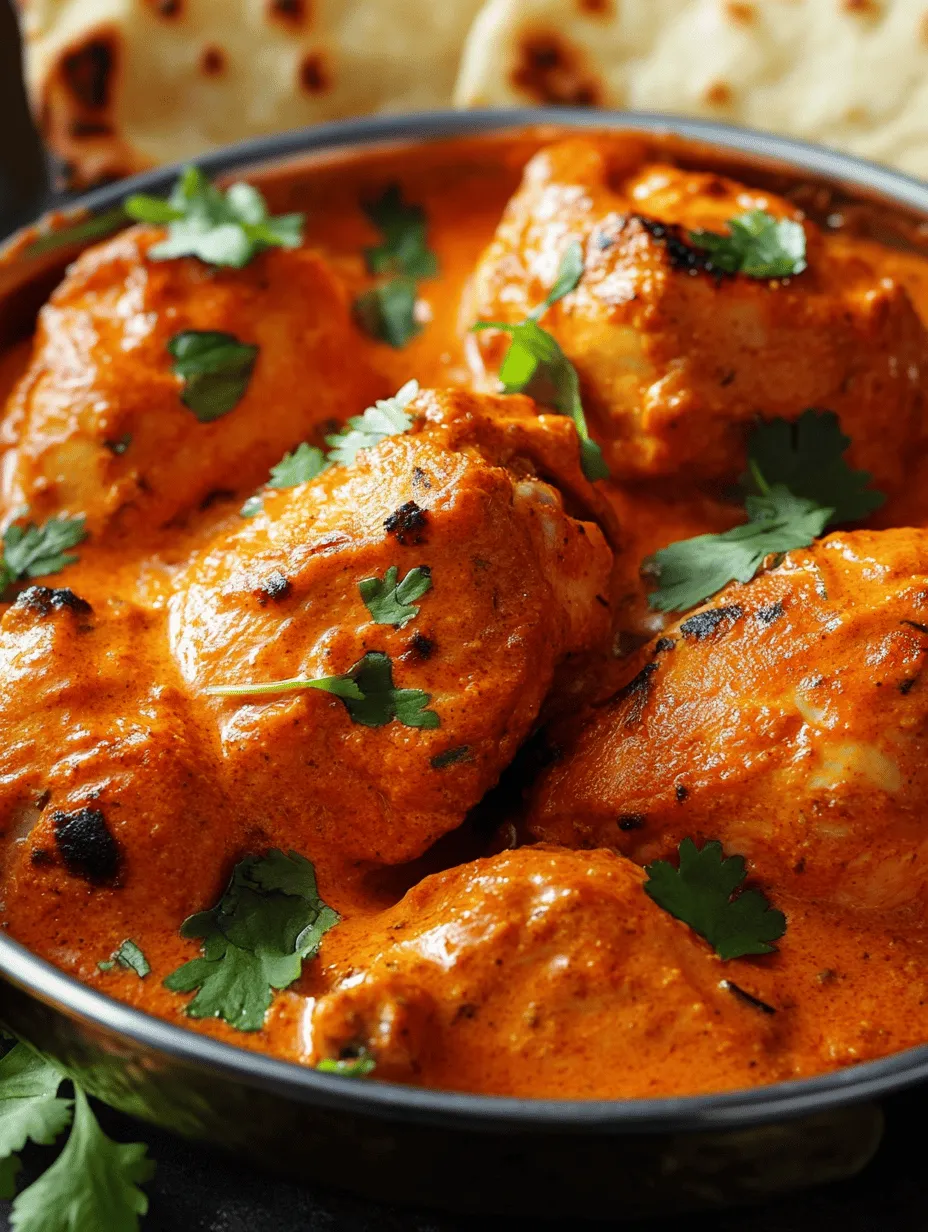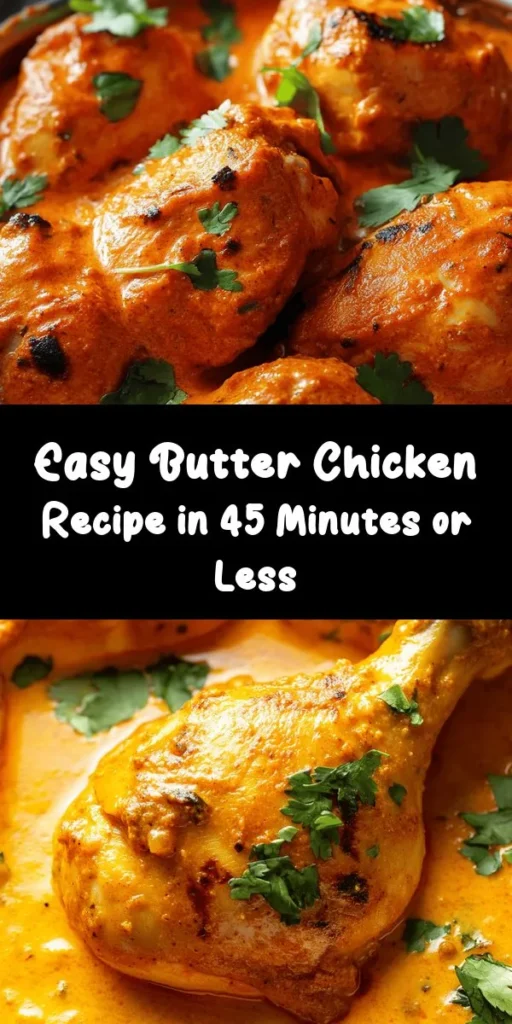Introduction
Butter Chicken, or Murgh Makhani as it is traditionally known, is a beloved dish that has found its way into the hearts and homes of food lovers around the world. Originating from India, this dish embodies the rich culinary heritage of Indian cuisine, characterized by its bold flavors, aromatic spices, and comforting textures. With its creamy tomato-based sauce and succulent pieces of chicken, Butter Chicken has become a staple at Indian restaurants and a favorite among home cooks.
In today’s fast-paced world, the appeal of creating quick and easy homemade meals has never been more significant. Butter Chicken is not only a crowd-pleaser but also an accessible dish that can be prepared in a relatively short amount of time. With simple ingredients that are often readily available, this recipe allows anyone to bring a taste of India into their kitchen without spending hours slaving over the stove. The combination of spices, cream, and butter creates a rich and indulgent flavor profile that is hard to resist, making it a perfect dish for family dinners or special occasions.
Understanding Butter Chicken
The Origin of Butter Chicken
Butter Chicken has a fascinating history that dates back to the 1940s in Delhi, India. It was created by the chefs at the Moti Mahal restaurant, who ingeniously combined leftover tandoori chicken with a rich tomato gravy, infused with butter and cream. This innovative dish quickly gained popularity, not just for its delicious taste but also for its ability to revolutionize the way chicken was prepared in Indian households.
Over the years, Butter Chicken has become synonymous with Indian cuisine, representing the culinary diversity of the region. The dish is celebrated not only for its taste but also for its cultural significance, showcasing the art of balancing spices and flavors — a hallmark of Indian cooking. As Butter Chicken has spread globally, it has adapted to various palates while still retaining its essence.
Traditional Ingredients and Flavor Profile
The beauty of Butter Chicken lies in its simple yet flavorful ingredients, each playing a vital role in creating its signature taste. Traditional recipes typically call for:
– Chicken: Usually, chicken thighs are preferred due to their tenderness and ability to retain moisture during cooking. The darker meat offers a richer flavor compared to chicken breasts.
– Yogurt and Lemon Juice: These ingredients are crucial for marinating the chicken. The yogurt adds creaminess and helps tenderize the meat, while lemon juice provides acidity, enhancing the overall flavor.
– Spices: A blend of spices such as garam masala, cumin, turmeric, and chili powder forms the backbone of the dish, creating a warm and aromatic profile that is both comforting and exciting. Each spice contributes its unique properties, making the sauce complex yet harmonious.
– Aromatics: Onions, garlic, and ginger form the aromatic base of the sauce, infusing it with depth and fragrance.
– Crushed Tomatoes and Cream: These ingredients are key to achieving the rich, creamy texture that Butter Chicken is known for. The combination of tomatoes and cream creates a luscious sauce that clings beautifully to the chicken.
– Butter: As the name suggests, butter is essential in this recipe, providing unparalleled richness and flavor that elevate the dish to a whole new level.
Regional Variations of Butter Chicken
While Butter Chicken has a standard recipe, it is also known for its regional variations across India. In some areas, you may find Butter Chicken made with different spices or cooked with additional ingredients like cashews or nuts. Some variations might even include a touch of sweetness, using ingredients like honey or sugar to balance the spice. Each region adds its unique twist, showcasing the versatility of this dish.
Ingredients Overview
To prepare your own Quick & Easy Homemade Butter Chicken, you will need the following ingredients. Here’s a detailed description of each component and its role in the recipe:
Chicken Thighs
Choosing the right cut of chicken is crucial for achieving tender and flavorful results. Chicken thighs are preferred because they contain more fat and connective tissue than chicken breasts, which means they remain juicy and succulent when cooked. For this recipe, boneless, skinless chicken thighs work best, as they can be easily cubed and marinated.
Yogurt and Lemon Juice
The marinade is essential for flavor and tenderness. Yogurt acts as a natural tenderizer, breaking down the protein in the chicken, while lemon juice adds acidity, which enhances the dish’s overall brightness. The combination not only infuses the chicken with flavor but also helps it maintain moisture during cooking.
Spices: Garam Masala, Cumin, Turmeric, Chili Powder
These spices form the flavor foundation of Butter Chicken. Garam masala, a blend of warm spices, adds depth and complexity. Cumin provides an earthy tone, turmeric adds a golden hue and mild flavor, and chili powder contributes heat. Together, they create a well-rounded spice profile, making every bite aromatic and flavorful.
Onions, Garlic, and Ginger
These aromatics are the backbone of the sauce. Finely chopped onions are sautéed to create a sweet and savory base, while garlic and ginger add pungency and warmth. Their combination is essential for building layers of flavor, ensuring a delicious and aromatic sauce.
Crushed Tomatoes and Cream
The use of crushed tomatoes is vital for achieving the signature sauce of Butter Chicken. They provide acidity and sweetness, balancing the richness of the cream. Adding cream transforms the sauce, making it creamy and luxurious, allowing it to coat the chicken beautifully.
Butter
Butter is a key ingredient in Butter Chicken, contributing to its name and significantly enhancing the dish’s richness. It adds a velvety texture and a deep flavor that is hard to replicate with any other fat, making the sauce irresistibly indulgent.
Garnishes and Serving Suggestions
To elevate your Butter Chicken, consider garnishing with fresh cilantro, which not only adds a pop of color but also a fresh flavor that complements the richness of the dish. Additionally, serving suggestions like fragrant basmati rice or warm naan bread make for the perfect accompaniment, allowing you to soak up the delicious sauce.
Step-by-Step Recipe Instructions
Marinating the Chicken
The first step in creating your Quick & Easy Homemade Butter Chicken is to marinate the chicken. This process is vital for enhancing the flavor and tenderness of the meat.
1. Prepare the Marinade: In a large bowl, combine plain yogurt, lemon juice, garam masala, cumin, turmeric, and chili powder. Mix well to create a smooth marinade.
2. Add the Chicken: Cut the chicken thighs into bite-sized pieces and add them to the marinade. Ensure that each piece is well-coated.
3. Marinate: Cover the bowl with plastic wrap or a lid and refrigerate for at least 30 minutes. For best results, marinate for up to 2 hours. This allows the flavors to penetrate the meat, ensuring a deliciously flavorful dish.
Cooking the Chicken
After marinating, it’s time to cook the chicken and prepare the rich sauce that will bring the dish together.
1. Sauté Aromatics: In a large skillet or saucepan, melt a tablespoon of butter over medium heat. Add finely chopped onions and sauté until they turn golden brown. This process can take about 5-7 minutes, so be patient; the caramelization adds depth to the sauce.
2. Add Garlic and Ginger: Once the onions are golden, add minced garlic and grated ginger. Sauté for another 1-2 minutes until fragrant, taking care not to burn them.
3. Cook the Chicken: Add the marinated chicken pieces to the skillet, along with any remaining marinade. Cook the chicken for about 7-10 minutes, stirring occasionally until it is cooked through and no longer pink in the center.
As you prepare your Butter Chicken, savor the enticing aromas that fill your kitchen. The combination of spices, cream, and buttery goodness will have your mouth watering in anticipation of the final dish.
Stay tuned for the next part of this article, where we will dive into creating the rich sauce and serving suggestions that will make your Butter Chicken a standout meal.

Explanation of the Initial Browning Process and Its Impact on Flavor
The journey to a delicious homemade Butter Chicken begins with the essential step of browning the chicken pieces in a hot pan. This technique, known as the Maillard reaction, is critical for developing complex flavors. When the chicken is seared, it forms a golden-brown crust that enhances the overall taste of the dish. This caramelization adds depth and richness, providing a savory foundation that harmonizes beautifully with the creamy sauce that follows.
To achieve perfect browning, ensure that the pan is adequately heated before adding the chicken. Working in batches prevents overcrowding, which can lead to steaming rather than browning. Aim for a temperature that allows the chicken to sizzle upon contact, creating that coveted golden exterior.
Sautéing Aromatics
Once the chicken is browned, it’s time to elevate the flavor profile with aromatics—onions, garlic, and ginger. These ingredients are the backbone of many Indian dishes, and their preparation is crucial for a flavorful Butter Chicken.
Techniques for Achieving the Right Texture and Flavor:
1. Onions: Begin by finely chopping the onions to ensure they cook evenly. Sauté them in the same pan used for the chicken, allowing them to pick up the residual flavors. Cook the onions until they turn translucent and lightly golden, which can take about 10 minutes. This slow cooking process develops their natural sweetness.
2. Garlic and Ginger: Mince fresh garlic and ginger, and add them to the pan once the onions are ready. Sauté for an additional 1-2 minutes until fragrant. Be careful not to burn these aromatics, as they can become bitter. The combination of garlic and ginger not only adds flavor but also introduces health benefits, such as boosting your immune system.
Building the Sauce
With the aromatics sautéed to perfection, the next step is to build a rich and flavorful sauce. This part of the recipe is where the magic happens.
Importance of Simmering the Tomatoes and How to Achieve the Right Consistency:
Add pureed tomatoes to the pan, allowing the mixture to come to a gentle simmer. Cooking the tomatoes helps to reduce their acidity and deepen the flavor. To achieve the right consistency for the sauce, simmer for 15-20 minutes, stirring occasionally. The goal is to allow the sauce to thicken and the flavors to meld beautifully.
You can also add a pinch of sugar to balance the acidity of the tomatoes, enhancing the overall taste of your Butter Chicken. Feel free to incorporate spices like garam masala, cumin, and coriander at this stage, as they’ll infuse the sauce with aromatic warmth.
Adding Cream and Butter
Now comes the moment where you transform your tomato base into the creamy, luxurious sauce that Butter Chicken is known for.
The Technique of Incorporating Dairy for a Creamy Texture and Balancing Flavors:
Once the sauce has thickened, reduce the heat to low and stir in heavy cream. This is where the dish gets its signature richness. For a smoother texture, you can blend the sauce before adding the cream or use a hand blender directly in the pan. The cream will lighten the sauce and balance the spices, making it irresistible.
Follow this with a generous dollop of butter, which adds an extra layer of richness and flavor. Stir until the butter is fully melted and incorporated, creating a velvety sauce that clings deliciously to the chicken.
Combining Everything
At this point, it’s time to bring all the elements together.
Final Cooking Tips to Ensure the Chicken is Fully Cooked and Flavors Meld Together:
Gently place the browned chicken pieces back into the pan, ensuring they are submerged in the sauce. Allow the dish to simmer for an additional 10 minutes, enabling the chicken to soak up the flavors of the sauce while ensuring it is fully cooked through. You can check for doneness by slicing a piece of chicken; it should no longer be pink inside.
For those who prefer a slightly thicker sauce, let it simmer uncovered for a few extra minutes. This step will help concentrate the flavors even more.
Garnishing and Serving
Presentation is key when it comes to serving Butter Chicken, as it’s not only about taste but also about visual appeal.
Presentation Tips for an Appealing Final Dish:
Once the Butter Chicken is cooked, transfer it to a serving dish. Garnish with freshly chopped cilantro or parsley for a pop of color and freshness. You can also drizzle a bit of cream on top for an elegant touch.
Suggestions for Pairing with Basmati Rice or Naan:
Butter Chicken pairs beautifully with fluffy basmati rice or warm, buttery naan bread. The rice will absorb the flavorful sauce, while naan is perfect for scooping up the chicken. Consider serving it alongside a simple cucumber salad or raita for a refreshing contrast.
Nutritional Benefits of Butter Chicken
Butter Chicken isn’t just delicious; it also offers various nutritional benefits when prepared with wholesome ingredients.
Analysis of the Nutritional Content of the Main Ingredients:
1. Chicken: A great source of protein, chicken helps in muscle repair and growth.
2. Cream and Butter: While they do add calories, they also provide healthy fats that are essential for nutrient absorption.
3. Tomatoes: Rich in vitamins C and K, tomatoes also contain antioxidants like lycopene, which may have heart health benefits.
Discussion on the Balance of Protein, Fats, and Carbohydrates:
This dish provides a balanced meal with protein from the chicken, healthy fats from the cream and butter, and carbohydrates from the rice or naan. This combination makes it a fulfilling option for family dinners.
Potential Health Benefits of Spices Used in the Recipe:
The spices used in Butter Chicken, such as turmeric and cumin, offer numerous health benefits. Turmeric is known for its anti-inflammatory properties, while cumin aids in digestion. Incorporating these spices not only enhances flavor but also contributes to a well-rounded diet.
Common Variations and Modifications
While the traditional Butter Chicken is a beloved classic, there are numerous ways to adapt it to accommodate dietary restrictions or personal preferences.
Suggestions for Adapting the Recipe for Dietary Restrictions:
1. Dairy-Free: Substitute the cream and butter with coconut milk and coconut oil for a dairy-free version without sacrificing creaminess.
2. Gluten-Free: Ensure that the naan is gluten-free or serve with rice instead to keep it safe for those with gluten sensitivities.
3. Vegetarian or Vegan Variations: Swap the chicken for paneer, tofu, or chickpeas. These ingredients are excellent sources of protein and can absorb the flavors of the sauce beautifully.
Adjusting Spice Levels for Different Palates:
If you or your guests have a sensitivity to spice, feel free to reduce the amount of chili powder and adjust the spices to suit your taste. Remember, cooking should be enjoyable, and personalizing recipes is part of the fun!
Conclusion
Making homemade Butter Chicken is not just about enjoying a meal; it’s about creating an experience filled with rich flavors and warm aromas. The ease of preparation combined with the depth of flavor makes it a perfect dish to share with family and friends.
As you experiment with this recipe, don’t hesitate to make it your own. Whether you stick to the classic version or try out variations, the joy of cooking and sharing this dish is what truly matters. Gather around the table, serve up some Butter Chicken, and savor the delightful experience of sharing a homemade meal with loved ones.



